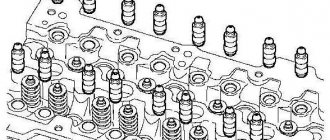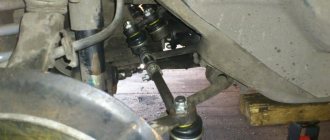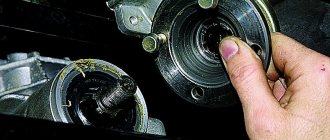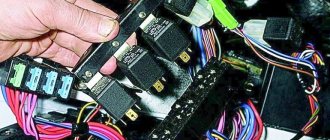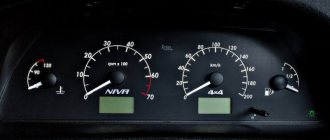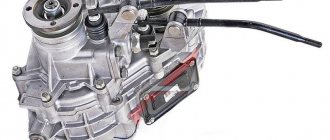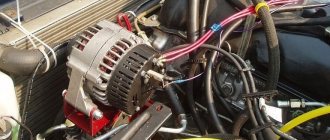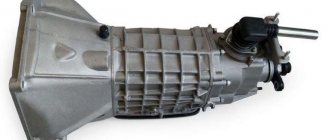The Chevrolet Niva SUV is equipped with two types of engines – Opel’s 1.8-liter Z18XE and the 1.7-liter VAZ-2123. If the Opel engine does not cause car owners virtually any problems, then various problems occur with the VAZ power unit.
- 1 Why Chevrolet Niva valves knock
- 2 Hydraulic compensators or adjusting bolts
- 3 Replacing hydraulic compensators on a Chevrolet Niva
- 4 Installing adjusting bolts on the Chevrolet Niva engine
- 5 Tips for replacing Chevrolet Niva hydraulic compensators
Niva Chevrolet hydraulic compensators often cause trouble for car owners - valves knock, the engine begins to work intermittently.
Why do Chevrolet Niva valves knock?
On regular “Classic” VAZ engines, rockers are installed in the gas distribution mechanism, and the valve clearances are adjusted with screws. On VAZ-2123 engines, instead of screws, hydraulic compensators are installed - they are made in the form of the same adjusting screws, but excess gaps in the hydraulic device are removed due to a plunger pair operating under oil pressure. The hydraulic compensator on the Shevinivsky engine is designed very simply and consists of four parts:
- the body itself;
- return spring;
- the lower and upper parts of the plunger pair (check valve with piston and the plunger itself).
Valve knocking in the Chevrolet Niva timing belt can occur for several reasons:
- there is insufficient oil pressure in the system;
- the engine oil is dirty, the oil channels are clogged;
- insufficient oil level in the lubrication system;
- the seat for the compensator is worn out;
- The parts themselves are of low quality and therefore require replacement.
Often the hydraulic compensators (HC) of the Chevy Niva knock only when cold, and after 30-40 seconds the knock disappears. The reason for this phenomenon is the supply of oil pressure to the hydraulics with a slight delay. To get rid of this problem, you can try replacing the oil and oil filter. When the valves knock “hot” - this is worse, you need to remove the camshaft from the main body and clean the channels. If flushing does not help, the hydraulic compensators need to be replaced.
Valve knocking can be different, and it does not always occur due to the fault of hydraulic valves; it can be caused by:
- worn camshaft cams;
- worn rocker surfaces;
- wear of the end of the valve stem itself.
But it often happens the other way around - due to hydraulic compensators, intense wear of the rockers and camshaft occurs. It is not recommended to drive with valve knock:
Related Posts
Preparing the car for summer
Proper running-in of a diesel engine after overhaul
Installing car speakers yourself
- parts of the gas distribution mechanism fail;
- due to large valve clearances, engine power decreases and fuel consumption increases;
- It's unpleasant to listen to such a knock.
A few words for thrifty car enthusiasts
Most often, hydraulic compensators do not fail completely, but become heavily contaminated, as a result of which they are simply unable to perform the task assigned to them correctly. Or only one breaks, as noted above. If you have the time and desire, you can try to take the hydraulic compensators that we previously threw out there back out of the bucket and carry out restoration work.
To do this, you need to disassemble the units and rinse everything thoroughly. After that, assemble everything in reverse order. Sometimes there are situations when additional replacement of adjusting bolts, which also fail over time, leads to good results. What to do is up to you to decide. The main thing is that the machine starts again and pleases you with the uniform hum of a steadily running engine.
Every car enthusiast, when operating a vehicle, certainly listens to how his car works. The appearance of extraneous noise during engine operation, as a rule, does not bring joy to the owner. The slightest malfunction requires urgent diagnosis and elimination of the problem. During operation, the engine generates heat, and when it is exposed to metal, the latter begins to expand. As a result, large gaps form on some parts, which lead to the appearance of extraneous noise. One of the problems can be knocking hydraulic compensators, which independently adjust the required clearance. In this article we will come to a broad explanation of the topic. What are hydraulic compensators (their design, purpose), why do they knock at different engine operating modes - read about all this below.
Hydraulic compensators or adjusting bolts
Hydraulic compensators installed from the factory are not always of high quality, and can begin to knock even after a short mileage. In some cases, the cause of the knocking is an untwisted main valve, that is, it was not tightened with the proper force during installation (tightening 2-2.2 kgf). But if the parts are already inoperable, the question arises - how to replace the faulty hydraulic valves.
The most reliable in the automotive market are considered to be the hydraulic compensators of the German company INA; also for the Chevy Niva, hydraulic compensators are produced by AvtoVAZ, and the hydraulic compensators are of the old and new type, they differ in the cylinder heads (cylinder heads became different for cars produced after 2008).
Hydraulic compensators are mainly sold individually, but they are not cheap - the price of one AvtoVAZ group is approximately 330-400 rubles, while an adjusting bolt costs only 30-50 rubles. If the driver agrees to adjust the valves every 10 thousand km, then it is better to install the bolts - there are fewer problems and the repair is cheaper.
"Death to hydrikas"
set “death to hydraulics” for the old-style cylinder head
Replacing hydraulic compensators with bolts on the Niva and Niva Chevrolet required the selection of parts, which, at my suggestion, began to be called “death to hydraulics”. The old and new model kits consist of the same components: 8 cylinder head screws, 4 rocker spring fixation plates, 8 adjusting bolts with locknuts, 8 rockers. Separately, I will focus only on the rockers. A separate story was dedicated to them. But I want to say something else. I had to go through the products of several factories to find a rocker for a small ball, with the correct profile and traces of heat treatment. With the “wrong” profile, the camshaft cam will hit the working surface, and you will never adjust the engine as expected. It is necessary that it smoothly rolls and “licks” the work site. The difference between the old and new sets is shown in the photo below.
differences between sets using the example of one cylinder
Replacing hydraulic compensators on a Chevrolet Niva
If the knocking of hydraulic compensators cannot be eliminated, then the parts should be replaced. You can replace the HA yourself, and it is done as follows:
- put the car on a level surface, turn off the engine, set the gear to neutral;
- First of all, remove the air duct, free the valve cover from the pipes;
- unscrew the 8 valve cover bolts;
- place a mark on the camshaft - the cast on the shaft housing at the front should coincide with the mark on the back of the gear;
- loosen the camshaft sprocket bolt, then remove the chain tensioner;
- the tensioner can be immediately recharged by recessing the plunger and fixing it in this position with a cap nut;
- unscrew the nuts holding the camshaft, dismantle the camshaft;
- we take out eight rockers, unscrew the hydraulic compensators;
- we install new “hydraulics” in place, tighten them with a force of 2 kg - it is important not to overtighten them, but you also cannot leave them too loose, they can unscrew;
- put the rocker in place; before installing the camshaft in place, set a mark - the pin should be opposite the hole in the flange (see the figure below);
- we fasten the camshaft, put the sprocket and chain tensioner in place;
- we tension the chain by loosening the cap nut on the tensioner, check the marks again, and fix the chain tension with the cap nut;
- install the valve cover, air duct and pipes.
We start the engine - at first the hydraulic compensators may knock, but as the engine warms up they fill with oil and the knocking should stop. That's it, the replacement of hydraulic compensators on the Chevrolet Niva can be considered complete.
What it is?
This element is a piston with the help of which automatic operation occurs. The operating principle of this device is quite simple. The bottom of the piston interacts with the camshaft cam.
A ball valve is installed in the piston, with the help of which the valve opens and oil flow begins. As the piston is filled with oil, pressure will be applied to the existing plunger, causing the piston to move all the way to the cam. As a result, the most optimal gap is automatically installed. When the cam acts on the piston, some of the oil escapes through the valve.
The piston drops slightly, thereby creating a gap. The latter on the hydraulic compressor is regulated by the flow of incoming oil. At this stage, we learned what hydraulic compensators (their devices) are.
Installing adjusting bolts on a Chevrolet Niva engine
New hydraulic lifters on the Chevrolet Niva are not cheap, and there is no guarantee that they will not knock again. In many cases, car owners install bolts instead of hydraulic valves - the price of spare parts is much cheaper, and the amount of work done is the same, only the valves have to be adjusted additionally. Replacing hydraulic compensators with bolts is easy to do, and disassembling the engine occurs in exactly the same way, only engine assembly is performed a little differently:
- thoroughly clean the wells into which the bolt bushings will be screwed from oil;
- install the plates, tighten the bolt bushings;
- screw the bolts into the bushing, install the rocker and springs;
- we put the camshaft and cam gear in place, tension the chain, do not install the oil rail;
- Now you need to adjust the valves - adjustment on the VAZ-2123 engine is performed in the same way as on any VAZ classic.
The valves are adjusted using a special wide 0.15 mm feeler gauge, and the gap can also be set using an indicator.
On the fourth cylinder (when the rip mark is aligned), valves 6 and 8 are adjusted (the valves are counted from the camshaft sprocket). We turn the crankshaft 180 degrees, adjust the 7th and 4th valves, after another 180? – 3 and 1, in another 180? – 2 and 5. Installing adjusting bolts instead of hydraulic compensators is worse in that you will now have to make adjustments approximately once every ten thousand kilometers.
Gaps of 0.15 mm are set on a cold engine; if they are smaller, the valves may burn out; with large gaps, an unpleasant knock occurs in the engine, the cylinders are not filled enough with the air-fuel mixture, and accordingly, engine power is lost.
Practice and life
jammed hydraulics and eaten rocker
When in 2008 AvtoTAZ switched to a new type of hydraulics, everyone was as happy as at a matinee in kindergarten. But certain runs passed and the engines began to rattle. I talked about this in more detail in the second part. But if it were only sounds)). In the photo there is a hydraulic valve from the engine, which, in the words of the owner of the car, “began to tap something.” The case is far from isolated. This picture is only possible on hydraulics that can jam.
adapter bushings are history
No special tricks were required to remove old-style hydraulics. Everything was perfect from the good old classics. But with the new sample we had to get a little tricky. Initially, I made a set of threaded bushings that screwed into the cylinder head. But there was one design flaw - it was necessary to file the cylinder head and slightly bend the plates. In general, not comme il faut. The final version was born when I accidentally found a CNC workshop that had not been sold for scrap.
Tips for replacing Chevrolet Niva hydraulic compensators
- If the hydraulic compensators are knocking on a Chevy Niva, you should not immediately rush to remove the valve cover - first you need to try replacing the engine oil in the engine.
- The engine should be filled with high-quality synthetic oil that complies with the SAE classification - 10W40 “synthetic” is suitable for summer; in winter it is better to use less viscous oil, for example, 5W40 or 0W30. If the oil is changed every 10 thousand km, and the oil is of high quality, then the likelihood of clogging the hydraulic compensators is not so great. Another tip is to fill in the same brand of engine oil.
- Old-style hydraulic compensators should not be over-tightened - overtightening will quickly cause them to fail. The force used is about 2 kgf, but if they are tightened too loosely, they can unwind.
- Before changing the HAs, you can first try rinsing them. Hydraulic compensators are washed in gasoline; for high-quality cleaning of toxins, the hydraulic compensators must be disassembled. After cleaning and assembly, the compensators should be checked: you need to push the plunger in with your fingers - if the hydraulic valve is in good condition, it should return back to its original position.
How to find out a faulty element
Having dealt with the causes of a possible malfunction in the engine, you need to consider a method for identifying the faulty part. In specialized workshops, a knocking hydraulic compensator is determined using acoustic diagnostics.
In addition, a knocking hydraulic compensator can be detected on a disassembled engine. To do this, you need to remove the valve cover and push each of the elements. Elements that easily sink will be faulty, since the lowest pressure prevails in them. The most important thing when diagnosing a malfunction is that the camshaft cam does not affect the units. It is impossible to determine the faulty element using other methods.
Flushing
Using new oil will not always help eliminate knocking. This is due to how severe the fault was. In this case, it is necessary to identify the faulty element and dismantle it for subsequent washing in gasoline. Often, due to the use of bad oil, gradual contamination of the compensator occurs. The removed compensators are mounted back into place in the order in which they were dismantled. It is worth noting that washing the elements is a rather complex process that will require special skills from the car owner.
The knock can be eliminated in the following way:
- Rotate the crankshaft until the valve corresponding to the faulty element opens.
- Then you need to turn the valve at an angle to restore the correct installation of the part.
- After this, you should start the engine and check for sound.
This method is applicable if the hydraulic compensators on a Grant car are knocking when cold. If the cause is not eliminated and the sound is still observed, a complete replacement of the part is required.
It is worth remembering that, due to the design of modern cars of domestic production, in all models of the latest generations, when starting the engine, a short-term knocking of the hydraulic compensators is observed. There is nothing wrong with this, and it is not always possible to eliminate such a malfunction even as a result of repairs in a specialized center or after a complete replacement of the part.
Transfer case
- Nut securing the suspension bracket to the pillow axis M10×1.25 26.5-32.3 (2.7-3.3)
- Nut securing the suspension bracket to the body M8 15.0-18.6(1.53-1.90)
- Nut securing transfer case housing covers, front axle drive housing, speedometer drive housing, control lever bracket M8 14.7-24.5(1.5-2.5)
- Differential lock switch M16×1.5 28.4-45.0 (2.9-4.6) Bolt securing the forks to the gear shift rods MB 11.8-18.6 (1.2-1.9)
- Bolt securing the forks to the differential lock rod M12×1.25 11.7-18.6(1.2-1.9)
- Nut securing the propeller shaft flange to the drive shaft and to the drive shafts of the front and rear axles M16×1.5 96.0-117.6(9.8-12.0)
- Driven gear mounting bolt М10×1.25 66.6-82.3 (6.8-8.4)
- Nut for securing the rear bearing of the drive shaft and the rear bearing of the intermediate shaft M18×1.5 96.0-117.6(9.8-12.0)
Oil selection
In such a situation, many will think about what kind of oil to pour when the hydraulic compensators are knocking. The answer is quite simple: you need to fill in lubricant of the required viscosity, which is recommended for use by the manufacturer. Currently, in the summer, it is most popular to use semi-synthetics in cars, that is, 10W-40. In winter, you should use 5W-40.
After changing the oil and filter, you should not be sure that there will be no sound. Quite the opposite: the knocking sound of hydraulic compensators “when cold” will also be heard due to the fact that there is no lubricant left in the pistons after draining. However, after the engine warms up, it should disappear, thereby confirming the correctness of the replacement decision.
Front suspension
- Nut of the lower bolts securing the cross member to the body side members M 12×1.25 66.6-82.3 (6.8-8.4)
- Nut of the upper bolts securing the cross member to the body side members M 12×1.25 66.6-82.3 (6.8-8.4)
- Nut of the bolt securing the rebound buffer bracket to the cross member M8 15.1-18.6 (1.53-1.90)
- Nut of the upper arm axle mounting bolt M 12×1.25 66.6-82.3 (6.8-8.4)
- Nut securing the upper end of the shock absorber M10×1.25 27.4-34.0 (2.80-3.46)
- Nut securing the lower end of the shock absorber M10×1.25 50.0-61.7 (5.1-6.3)
- Front wheel hub bearing nut M 18×1.5 cm, “Chassis”, p. 169
- Bolt securing the caliper to the steering knuckle M10×1.25 29.1-36.0 (2.97-3.67)
- Anti-roll bar mounting nut M8 15.0-18.6(1.53-1.90)
- Nut securing ball pins to steering knuckle M 14×1.5 83.3-102.9 (8.5-10.5)
- Nut for fastening the brace to the suspension cross member M 12×1.25 66.6-82.3 (6.8-8.4)
- Nut for fastening the extension to the body M 16×1.5 104.9-169.5 (10.7-17.3)
- Nut connecting the lower arm axis to the cross member M 16×1.5 114.7-185.2(11.7-18.9)
- Nut for fastening ball joints to suspension arms M8 20.60-25.75 (2.10-2.63)
- Wheel bolt nut M 12×1.25 62.4-77.1 (6.37-7.87)
- Upper suspension arm axle nut M 14×1.5 63.7-102.9 (6.5-10.5)
- Nut of bolts securing the swing arm M 12×1.25 66.6-82.3 (6.8-8.4)
Steering
- Steering housing mounting bolt nut M10×1.25 33.3-41.2 (3.4-4.2)
- Nut of the pendulum arm bracket mounting bolt M10×1.25 33.3-41.2 (3.4-4.2)
- Ball pin nut for steering linkages** M 14×1.5 42.1-53.0 (4.3-5.4)
- Nut securing the steering shaft bracket and ignition switch M8 15.0-18.6 (1.53-1.90)
- Steering wheel nut M 16×1.5 31.4-51.0 (3.2-5.2)
- Bipod fastening nut M20x1.5 199.9-247.0 (20.4-25.2)
- Pendulum arm axis nut M 14×1.5 63.7-102.9 (6.5-10.5)
Instructions, procedure
After dismantling the expansion joints, they are cleaned from the outside with brushes with artificial bristles. Then the parts are washed in the first container, which has previously been filled with liquid for washing hydraulic compensators. Each element is lowered into the container and the check ball valve is pressed several times with a wire. Then press on the plunger.
If the stroke of the plunger becomes easy, then the compensator is washed in a second container. However, before this, all liquid is drained from the compensator. To do this, just squeeze the ball. The oil circulation channels are washed using a syringe.
An important point in performing this operation is checking the mechanisms. So, by lowering the compensator into the third container with a cleaning agent, liquid is drawn into the part.
Then the part is lowered and pulled out so that the plunger faces up. If you press your finger on it, it will not move. When everything is exactly like this, the parts are returned to their place and the engine is assembled.
Using this simple procedure, you can restore the hydraulic compensators to their functionality. Even an expensive Liqui Moly hydraulic compensator flushing additive will be no more expensive than replacing these elements with new ones.
The result of ignoring repairs
If the driver heard that the hydraulic compensator was knocking “when cold”, but still ignored the repairs, the consequences may not be the most pleasant, despite the fact that compensators do not have much effect on the wear of other engine components.
As a result of untimely repairs, problems with the engine lubrication system may occur. In addition, signs of serious problems will be a decrease in the overall power of the power unit, as well as a drop in the vehicle’s acceleration speed and an increase in fuel consumption when driving at medium settings.
So, we found out why the hydraulic compensator knocks “when cold.”
